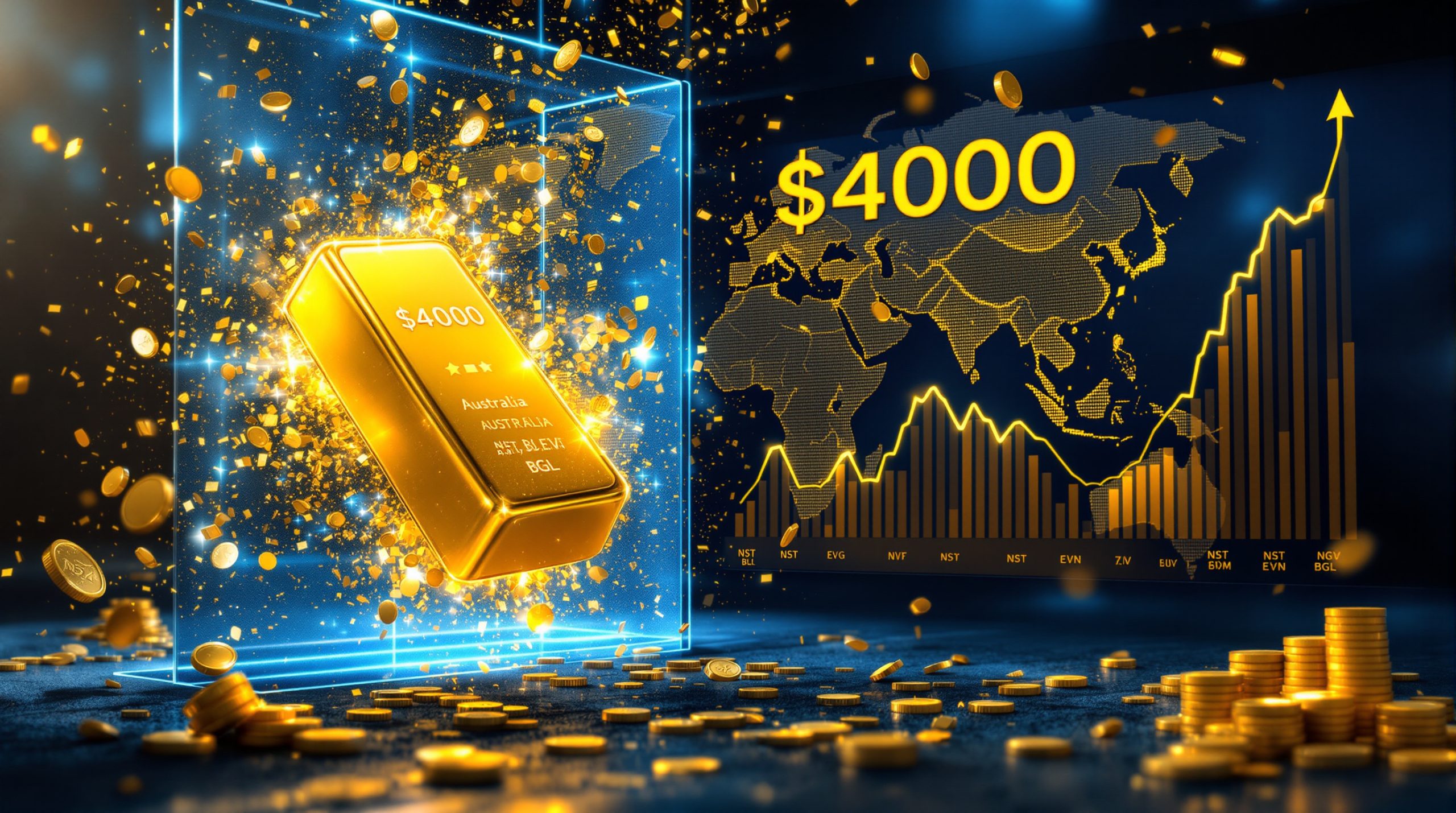Gold Surpasses $4000 Mark: Historic Milestone and Market Implications
Gold's breakthrough of the $4,000 psychological barrier represents a defining moment in precious metals markets. This historic milestone, achieved in October 2025, marks a culmination of building momentum in gold markets driven by a perfect storm of economic factors. With gold establishing itself as Australia's second most valuable export behind iron ore, the implications reach far beyond mere price movement, affecting everything from mining stocks to gold market performance.
Why Has Gold Reached This Historic Price Point?
Economic Uncertainty Driving Safe Haven Investment
Global economic uncertainties have significantly fueled gold's ascent to unprecedented heights. Investors worldwide have increasingly sought refuge in tangible assets amidst persistent inflation concerns and geopolitical tensions. The breaking of the $4,000 barrier didn't happen overnight but resulted from sustained market pressure as traditional investment vehicles showed signs of volatility.
Market analysts have long predicted this milestone, with many pointing to the Wall Street rally showing signs of stalling despite the S&P 500 and Nasdaq composite both landing intraday highs. As noted by market observers at The Market Online, investors have begun heeding warnings that markets have become "a little too overenthusiastic" about the late-2025 equities rush, pushing capital toward gold as a stability measure.
Central Bank Purchasing Trends
Central banks globally have been on an unprecedented gold buying spree throughout 2025, creating substantial price momentum. This institutional accumulation reflects a strategic pivot away from traditional currency reserves, particularly as questions about the US dollar's long-term dominance continue to circulate in financial markets.
The trend represents more than simple diversification—it signals a fundamental reassessment of gold's role in national reserves. Central banks added over 1,000 tonnes to their gold holdings in the past year alone, according to industry data, with emerging economies leading much of this accumulation as they seek to reduce dependence on any single currency.
Supply-Demand Dynamics Shifting
Gold production has struggled to keep pace with surging demand, creating favorable conditions for sustained price appreciation. Mining output constraints, declining ore grades, and fewer major discoveries have intensified supply-side pressure that supports the current bull market.
Annual gold mining production has remained relatively flat at approximately 3,500 tonnes worldwide, while demand has consistently exceeded 4,500 tonnes when accounting for investment, jewelry, and industrial applications. This fundamental imbalance, combined with increasing mining costs, has created a structural foundation for gold's price surge that many analysts believe will persist through 2026.
What Does Gold's Price Surge Mean for Global Markets?
Indicator of Economic Sentiment
The gold price breaking through $4,000 serves as a powerful barometer of market sentiment. This milestone reflects widespread concerns about economic stability and signals investors' diminishing confidence in traditional financial assets and fiat currencies.
Historically, significant gold price milestones have coincided with periods of market uncertainty. The current breakthrough comes as market participants question the sustainability of equity valuations and express concerns about inflation risks despite central bank assurances. The simultaneous achievement of stock market highs and all-time gold highs analysis creates a curious market dichotomy that suggests underlying caution despite surface-level optimism.
Impact on Equity Markets
Gold's dramatic rise has coincided with increased volatility in equity markets, with some sectors showing divergent performance:
- Mining stocks, particularly gold producers, have seen significant valuation increases, with the ASX gold index outperforming broader market indices
- Technology and growth stocks have experienced pressure as capital rotates toward safe-haven assets
- Financial sector stocks face mixed reactions as higher gold prices often correlate with concerns about systemic stability
The bifurcation between gold mining equities and the broader market has created specialized investment opportunities. Companies with established production profiles and manageable costs have particularly benefited, seeing their margins expand dramatically with each $100 increase in gold prices.
Correlation with Interest Rate Policies
The precious metal's price surge has occurred despite varying interest rate environments, challenging the traditional inverse relationship between gold and rates. This suggests structural changes in how investors view gold's role in a diversified portfolio.
While gold historically performs best in low real interest rate environments, its breakthrough of $4,000 has occurred in a mixed rate environment. This indicates investors are prioritizing gold's stability and record-high gold inflation hedge characteristics over its opportunity cost relative to yield-bearing assets—a significant shift in market psychology with long-term implications.
How Are Australian Gold Producers Benefiting?
ASX Gold Sector Performance
The Australian gold sector has experienced substantial gains, with the S&P/ASX All Ordinaries Gold Index outperforming broader market indices. Major producers like Northern Star Resources (ASX:NST), Evolution Mining (ASX:EVN), and Bellevue Gold (ASX:BGL) have seen their share prices surge as profit margins expand significantly at current gold prices.
With gold trading at historic highs, Australian producers are experiencing cash flow bonanzas. Northern Star Resources, for example, reported record quarterly production figures alongside dramatically improved margins, with all-in sustaining costs (AISC) of approximately AUD$1,650 per ounce providing over AUD$4,400 in margin at current exchange rates.
Production Cost Advantages
Australian gold producers enjoy several competitive advantages in the current environment:
| Factor | Impact on Australian Producers |
|---|---|
| Currency exchange | AUD/USD rate provides margin protection |
| Operational efficiency | Advanced mining technology reduces costs |
| Established infrastructure | Lower capital requirements for expansion |
| Regulatory environment | Stable mining policies support investment |
The Australian dollar trading at 65.8 US cents provides a significant buffer for domestic producers compared to international competitors. Even if gold prices were to retrace somewhat, Australian producers would maintain substantial margins due to this currency advantage, making them particularly attractive investment propositions.
Emerging Players Gaining Attention
Several emerging Australian gold companies have attracted investor interest as the gold rally intensifies:
- Caprice Resources (ASX:CRS) has seen increased trading volume and share price appreciation as investors look beyond established producers
- New Murchison Gold (ASX:NMG) has benefited from renewed focus on its development projects in Western Australia's prolific gold regions
- Green and Gold Minerals, which recently listed on the ASX under the ticker "GG1" at 20 cents per share, represents the latest entrant riding the gold wave
Junior explorers with promising discoveries have secured easier access to capital for advancement, with exploration budgets expanding dramatically across the sector. This has accelerated development timelines for many early-stage projects that might otherwise have struggled to advance in a lower price environment.
What Are The Key Drivers Behind Gold's Historic Run?
Geopolitical Tensions Creating Safe Haven Demand
Ongoing conflicts and diplomatic tensions have heightened global uncertainty, driving investors toward gold as a traditional safe haven. The metal's stateless nature and universal acceptance make it particularly attractive during periods of geopolitical instability.
Regional conflicts, trade tensions, and shifting alliances have all contributed to a sense of global unpredictability that typically benefits gold. According to a recent Reuters report, the metal's 5,000-year history as a store of value provides psychological comfort during times when political systems appear less stable, contributing significantly to its recent price appreciation.
Currency Devaluation Concerns
Persistent inflation and expansionary monetary policies have raised concerns about currency devaluation across major economies. Gold's historical role as an inflation hedge has attracted investors worried about the long-term purchasing power of fiat currencies.
While official inflation figures have moderated from their post-pandemic peaks, many investors remain skeptical about the long-term purchasing power of major currencies given unprecedented levels of government debt. Gold's physical, immutable nature serves as a counterpoint to potentially unlimited currency creation, driving institutional and retail demand.
Technological Demand Creating New Price Pressures
Beyond investment demand, gold continues to see steady consumption from technology sectors, particularly in electronics manufacturing. The metal's unique properties make it irreplaceable in certain high-tech applications, creating baseline demand regardless of price fluctuations.
Gold's excellent conductivity, corrosion resistance, and malleability have made it essential in advanced electronics, from smartphones to spacecraft. With approximately 10% of global gold demand coming from industrial applications, this sector provides a demand floor that complements investment flows and supports price stability even during market fluctuations.
How Does Gold Compare to Other Investment Assets?
Performance Against Traditional Safe Havens
Gold has outperformed most traditional safe-haven assets in recent years, including:
| Asset Class | 3-Year Performance | Correlation with Gold |
|---|---|---|
| US Treasuries | Negative real returns | Increasingly positive |
| Japanese Yen | Depreciation against USD | Historically positive, now mixed |
| Swiss Franc | Moderate appreciation | Moderately positive |
| Gold | +45% (approximate) | – |
This outperformance has forced many institutional investors to reconsider optimal portfolio allocations, with many increasing their gold exposure beyond traditional levels. The diminished effectiveness of bonds as portfolio stabilizers has particularly benefited gold as investors seek alternative methods of reducing overall volatility.
Digital Assets vs. Physical Gold
The relationship between gold and cryptocurrencies has evolved, with both sometimes competing for similar investment narratives around inflation protection and financial system alternatives. However, gold's millennia-long track record continues to attract institutional investors seeking proven stability.
While cryptocurrencies initially positioned themselves as "digital gold," their higher volatility and regulatory uncertainties have reinforced gold's position as the premier store of value. Many wealth managers now recommend a combined approach, with gold providing stability and cryptocurrencies offering asymmetric return potential within well-diversified portfolios.
Real Assets Comparison
Among real assets, gold has shown strong relative performance:
- Outpaced most commercial real estate returns, which have struggled with changing work patterns
- Competitive with residential property in many markets, without the management complications
- Superior to most commodity indices, which have shown higher volatility
Gold's liquidity advantage over other real assets has particularly contributed to its attractiveness during periods of market stress. Unlike property or infrastructure investments, gold positions can be adjusted quickly in response to changing market conditions without significant transaction costs or time delays.
What Are Analysts Forecasting for Gold's Future?
Price Projections and Targets
Market analysts have revised their gold price forecast outlook upward following the $4,000 breakthrough:
- Near-term resistance levels are being identified around $4,200-4,300
- Year-end targets now commonly range from $4,100-4,500
- Long-term projections suggest potential for $5,000+ by 2027 under certain economic scenarios
While forecasts vary considerably, the consensus has shifted decidedly bullish, with few analysts expecting significant price retracement in the near term. Technical analysts point to the decisive nature of the $4,000 breakthrough as evidence of strong momentum that typically presages further gains.
Potential Catalysts for Further Gains
Several factors could drive continued appreciation:
- Further central bank purchases, particularly from emerging economies seeking to reduce dollar dependency
- Escalation of existing geopolitical conflicts creating additional safe-haven flows
- Unexpected inflation surges in major economies undermining confidence in fiat currencies
- Stock market corrections driving flight to safety and portfolio rebalancing
The structural supply-demand imbalance provides a solid foundation for continued price strength even without additional catalysts. With mining output constraints unlikely to resolve in the short term, even modest increases in investment demand could drive prices significantly higher.
Downside Risks to Consider
Despite the strong momentum, several factors could interrupt gold's ascent:
- Unexpected hawkish shifts in monetary policy increasing opportunity costs for holding non-yielding assets
- Significant strengthening of the US dollar reducing gold's attractiveness for non-dollar investors
- Resolution of major geopolitical tensions reducing safe-haven demand
- Rapid improvement in global economic growth outlook shifting capital toward productive assets
Disclaimer: While the outlook for gold remains positive, investors should recognize that past performance is not indicative of future results. All investments carry risk, and gold prices can experience significant volatility despite the metal's reputation for stability.
How Can Investors Participate in the Gold Market?
Direct Ownership Options
Investors have multiple avenues for direct gold exposure:
- Physical bullion (coins and bars) offering direct ownership without counterparty risk
- Gold ETFs tracking spot prices while eliminating storage concerns
- Gold mining stocks and ETFs providing operational leverage to gold prices
- Gold futures and options contracts for sophisticated investors seeking leverage or hedging capabilities
Each approach offers different risk-return characteristics and practical considerations. Physical gold provides maximum security but requires storage solutions, while mining stocks offer potential outperformance through operational leverage but introduce company-specific risks.
Portfolio Allocation Strategies
Financial advisors typically suggest different gold allocation approaches based on investor profiles:
| Investor Type | Typical Allocation Range | Preferred Exposure Method |
|---|---|---|
| Conservative | 5-10% | Physical gold, major ETFs |
| Balanced | 3-7% | Mix of ETFs and senior producers |
| Growth-oriented | 2-5% | Junior miners, exploration companies |
| Speculative | 0-10% | Junior explorers, options strategies |
Portfolio construction experts typically recommend starting with a core position in physical gold or major ETFs, then potentially adding mining equities for investors comfortable with higher volatility in exchange for greater upside potential.
Tax Considerations for Gold Investors
Different gold investment vehicles carry varying tax implications:
- Physical gold may be subject to capital gains tax when sold, with rates varying by jurisdiction and holding period
- Mining stocks may offer dividend income alongside appreciation potential, with potential tax advantages
- ETFs have different tax treatments depending on structure and jurisdiction, requiring careful consideration
Tax efficiency should be an important consideration in structuring gold investments, particularly for high-net-worth individuals. Many investors utilize a combination of vehicles to optimize after-tax returns while achieving desired exposure to gold price movements.
What Does Gold's Rise Mean for Australia's Economy?
Export Value Implications
With gold surpasses $4000 mark, it is now Australia's second most valuable export behind iron ore, with significant implications for national trade balances and economic performance. The increased export value strengthens Australia's trade position and supports the Australian dollar.
At current prices, Australia's gold exports are worth approximately AUD$25 billion annually, making a substantial contribution to the nation's trade surplus. This export strength provides economic stability during periods when other commodity prices might fluctuate more dramatically.
Mining Sector Employment and Investment
The gold sector's prosperity has stimulated:
- Increased exploration budgets across the industry, with junior companies particularly benefiting
- New project development and mine expansions creating construction and operational jobs
- Employment growth in mining regions, often in areas with limited alternative opportunities
- Supporting industries experiencing increased demand for equipment, services, and logistics
The employment impact extends far beyond direct mining jobs, with each mining position typically supporting multiple roles in supply chain and service industries. Regional communities particularly benefit from this multiplier effect, creating economic resilience in areas that might otherwise face demographic challenges.
Regional Economic Benefits
Gold mining operations provide substantial economic benefits to regional communities through:
- Direct employment opportunities creating high-wage jobs in rural areas
- Local procurement spending supporting small businesses and service providers
- Community development initiatives funded by mining royalties and corporate contributions
- Infrastructure improvements that benefit broader community needs beyond mining operations
Many regional Australian communities have historical connections to gold mining dating back to the 19th century gold rushes. The current price surge has revitalized these traditional mining areas, reversing population declines and stimulating regional economic development that extends far beyond the mining sector itself.
FAQs About Gold's $4000 Milestone
What factors contributed most to gold breaking the $4000 barrier?
The convergence of central bank buying, geopolitical uncertainties, inflation concerns, and limited supply growth created perfect conditions for gold's historic price breakthrough. Institutional investor reallocation from traditional assets to gold provided additional momentum, particularly as equity markets showed signs of overvaluation despite reaching record highs.
How does gold's performance compare to other commodities in 2025?
Gold has outperformed most major commodities in 2025, including silver, platinum, and base metals. This outperformance highlights gold's unique monetary properties beyond its industrial applications. While other commodities have been constrained by economic growth concerns, gold has benefited from its safe-haven status.
Will gold prices continue to rise throughout 2025?
While predictions vary, most analysts expect gold to maintain its strength through 2025, with potential for further gains depending on monetary policy decisions, geopolitical developments, and broader market conditions. The structural supply constraints combined with persistent investment demand create favorable conditions for continued price appreciation.
How are gold ETFs performing compared to physical gold?
Gold ETFs have closely tracked physical gold prices while experiencing record inflows, demonstrating strong investor preference for convenient exposure to the metal without storage concerns. Major gold ETFs now hold over 4,000 tonnes of physical gold, representing one of the largest concentrations of the metal outside central bank reserves.
What impact does gold's rise have on jewelry demand?
Traditional jewelry demand has shown elasticity at higher price points, with some markets experiencing reduced volume purchases offset by higher per-unit values. However, investment-oriented jewelry demand remains robust in key markets like India and China, where gold jewelry serves dual purposes as adornment and wealth preservation, according to gold market investment strategies.
Looking for the Next Big Mineral Discovery?
Discovery Alert's proprietary Discovery IQ model delivers instant notifications on significant ASX mineral discoveries, enabling subscribers to identify actionable investment opportunities before the broader market. Explore why major discoveries can lead to substantial returns by visiting the Discovery Alert discoveries page and position yourself to capitalise on the next market-moving announcement.




